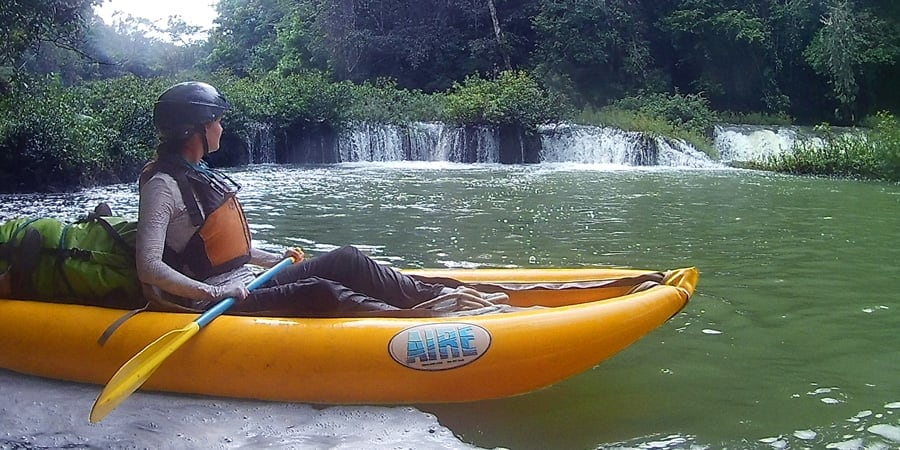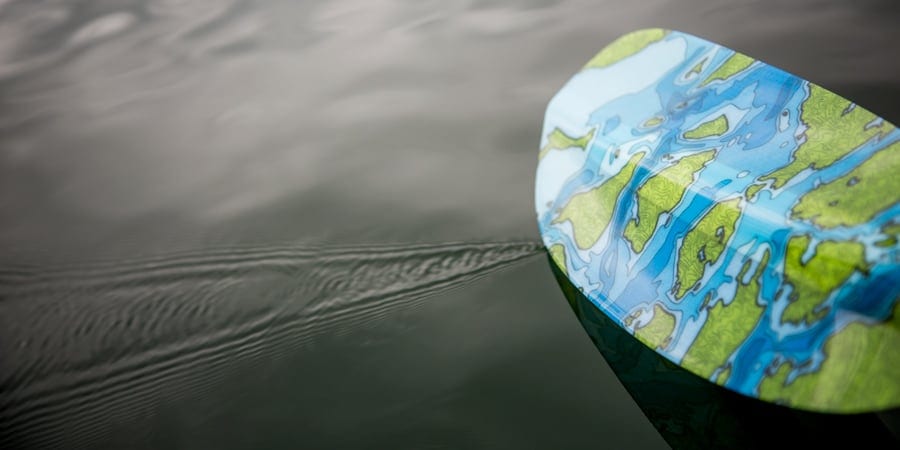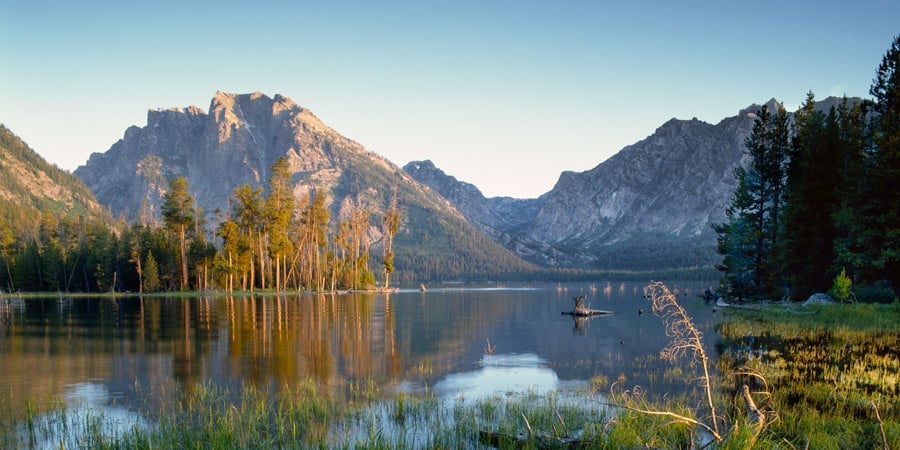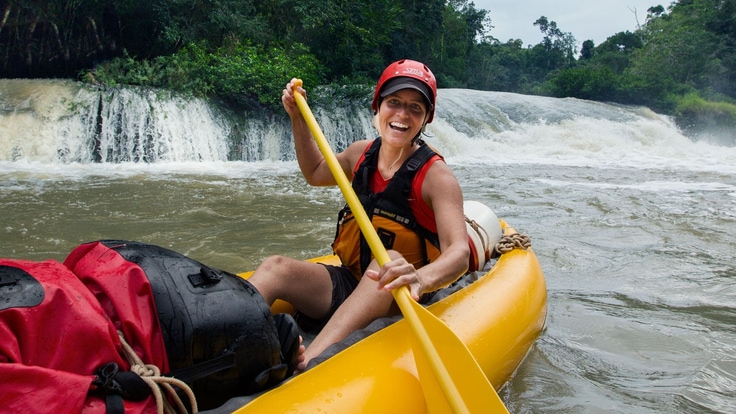Have you hiked to a beautiful alpine lake or meandering river and wished you had a way to get on the water? With packrafting, you can. Packrafting turns all those blue circles and squiggly lines that represent lakes and rivers on your hiking map into possibilities for exploration.
To help get you started with packrafting, this article covers the basics of the sport, including:
- What is packrafting?: Packrafting is basically a combination of backpacking and rafting, but people also use other modes of transportation, such as mountain bikes, to access lakes and rivers.
- Gear and clothing for packrafting: A raft, pump, paddle and PFD are the core essentials.
- Tips for packrafting: Helpful tips, such as where to go for your first outing, will help you get started.
What is Packrafting?

Packrafting is a sport that uses an individual-size inflatable boat called a packraft that's tough and durable but also light and compact. A packraft is designed to fit in your backpack, or even on a bike, so you can carry it into the mountains to reach rivers and lakes. You can expect a packraft and its accompanying gear (such as a paddle, pump and PFD) to weigh about 10-15 pounds.
The places you can go with a packraft are many. People have used them to link up trails and rivers on hardcore journeys through Alaska and across Iceland, but they're also great for leisurely days of paddling on a local lake or gently flowing river.
Quite often, people will use a packraft to make a loop out of a linear trail. You can hike in for several hours, or several days, and then float your way back to the trailhead on a river. When you're planning your trip, keep in mind that by harnessing the power and speed of rivers, you can cover distance more quickly and possibly reach areas you otherwise wouldn't be able to.
Gear and Clothing for Packrafting

The amount of gear and clothing you need for a packrafting trip depends on the type of adventure you're planning. If you're doing a multiday outing that combines hiking, camping and paddling, you'll need much more gear than you will on a simpler single-day trip.
Here are the packrafting essentials you will need in addition to any hiking, biking and/or camping gear:
Packraft: Packrafts are built to be lightweight, packable, durable and easy to inflate. Most packrafts are tough enough to handle everything from a lazy river to churning Class III rapids. Some people do run Class IV or higher rapids in packrafts; if this interests you, make sure your packraft has whitewater-specific features, such as a spraydeck and skirt, and that you have advanced skills.
Many packrafts have clever storage compartments in the tubes that make up the body of the raft. Before inflating your packraft, pack your gear inside waterproof dry bags and then stash those bags inside the storage compartments. Packrafts also have lash points on the outside for strapping down gear, such as a backpack or even a mountain bike.
Pump: Packrafts come with a lightweight inflation bag that you use to inflate the raft. You attach the bag to a valve on the raft and then scoop air with the bag and squeeze the air into the raft. With a little practice, you'll get the hang of the technique and be able to inflate a raft in five to 10 minutes.
Repair kit: Most packrafts come with a repair kit so you can patch a hole if one develops.
Paddle: Most packrafters use a lightweight kayak paddle that breaks down into four pieces for easy packing on the approach. A paddle made from fiberglass and/or carbon will be your lightest option. If you'll be navigating rivers with rapids, make sure your paddle is built to handle whitewater. To learn more about paddles, see Kayak Paddles: How to Choose.
PFD (Personal Flotation Device): A PFD is an essential piece of safety gear that needs to be worn any time you're on the water. You want a PFD that fits snug but comfortably and that won't limit your range of motion while paddling.
Learn more about choosing a PFD in our article, PFDs: How to Choose.
Kayaking helmet: If you're paddling on placid alpine lakes, you can leave this piece of gear behind, but if you'll be running rapids with your packraft, a helmet is a must-have item.
Clothing: When dressing for packrafting you need to think about the approach and the paddling phases of the adventure. If you'll be hiking or biking several miles to get to a river or lake, dress in clothing and footwear that's comfortable for those activities. Items that wick moisture and dry quickly are preferable. And, by choosing versatile items that can be used on the approach and while paddling, you can reduce the weight you need to carry.
Depending on water and air temperatures, you may need paddling-specific clothing, such as a wetsuit, dry suit, paddling jacket, paddling booties and/or paddling gloves. Be sure to also keep in mind the importance of wearing sun protective clothing.
You can learn more about paddling-specific clothing in our article, What to Wear Kayaking.
Tips for Your First Packrafting Outing

Practice at home: Try inflating and packing gear inside and on your packraft at home. Once you've run through this process a couple times at home, doing it by the side of a river won't seem quite so daunting.
Go with a buddy: When you head out on the water, it's always a good idea to go with a friend. You can keep an eye on each other and provide assistance if one of you needs help.
Start easy: For your first time out, head to a local pond or lake so you can get used to paddling a packraft without the added challenge of a current. Practice launching and landing your boat and get a feel for maneuvering it. You can even intentionally fall out (make sure you won't hit anything) and practice getting back into the boat.
Rivers vs. lakes: Packrafts perform best with the flow of a river, but serene alpine lakes can also be fun to explore (just don't expect the boat to track as straight as a kayak).
Pick a river that matches your skills: If you have relevant paddling experience, such as whitewater kayaking, you'll likely take to packrafting quickly. But be conservative and head out on a river that matches your skills. If you've never been down Class III rapids before, don't take your packraft on a Class III river.
Go with an experienced packrafter: If you know an experienced packrafter, see if they will take you out and show you a few things. Finding someone who can share tips and teach you how to navigate obstacles in the river can be invaluable.
Get training: A number of outfitters offer courses in packrafting. If you can't find a packrafting-specific course, a whitewater kayaking course can also teach you a lot of the skills you will need. Also, consider a swiftwater rescue course so you'll be prepared if something goes wrong on the river.

